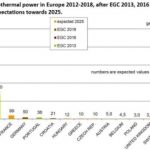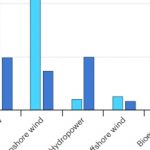A new analysis reveals that installing geothermal heat pumps in 70% of U.S. buildings can reduce the need for new long-distance transmission lines by 33%, explains Kelly MacGregor at NREL. The main message is that, though geothermal deployment is seen as expensive, the avoided costs are significant. Those transmission lines won’t be needed because geothermal is always local and can be deployed in both urban and rural places. Though the widespread … [Read more...]
First-of-a-kind U.S. utility pilots community Geothermal to cut emissions and bills
For the first time in the U.S. a utility is piloting a community geothermal project to heat and cool 40 buildings and cut customers’ bills. Success will lead to scale up and replication, explains Adele Peters writing for the World Economic Forum. The case for community geothermal is very strong. Though geothermal’s up-front costs of installing pipes deep underground are high, running costs are low. The pilot, in Framingham (Massachusetts), will … [Read more...]
Geothermal Heat Pumps: can new U.S. “IRA” support make it go mainstream?
Biden’s Inflation Reduction Act in the U.S. is meant to drive forward the best clean energy solutions. To help make sure geothermal heat pumps play their fullest role, RMI has done a study of its benefits as well as published guides on how developers can take advantage of the various new laws and support mechanisms. Lauren Reeg, Mike Henchen, Chris Potter and Chris Stone at RMI start with a summary of the technology and its applications, before … [Read more...]
Geothermal’s full potential: 24/7 power everywhere, storage, environmental mineral extraction
Geothermal is not just for generating energy. It can be used for storage and extracting minerals too. Kelly MacGregor at NREL summarises the research into taking geothermal to the next level and making it a solution to multiple challenges. Depending on how far down you dig, geothermal is available for running utility-scale power plants as well as heating and cooling individual districts, buildings and houses. And new techniques are being … [Read more...]
‘Green Deal Industrial Plan’ explainer: 40%+ of the top low-carbon technologies must be made in the EU by 2030
The EC’s new series of proposed targets and reforms, contained in its Green Deal Industrial Plan, aim to ensure that at least 40% of the EU’s low-carbon technologies will be made within its borders by 2030. The eight “strategic net-zero technologies” are: Solar (power and thermal); Onshore and offshore wind; Batteries and energy storage; Heat pumps and geothermal; Electrolysers and fuel cells; Sustainable biogas/biomethane; CCS; Grid … [Read more...]
Utah: 140MW Geothermal bid can beat the cost and performance of the proposed Nuclear SMR
The U.S. state of Utah is processing an agreement for a new Small Modular Reactor (SMR) to provide baseline and dispatchable power. The SMR bid quotes a price of $89/MWh. But cost overruns will tie the state’s consumers to whatever high prices entail, says Dennis Wamsted at IEEFA. Now a geothermal bid from NV Energy has been presented that offers the same capacity at around $70/MWh. Wamsted explains why the 140MW geothermal project would meet … [Read more...]
Can Enhanced Geothermal Systems be used as grid-scale batteries? Anywhere!
The US Department of Energy aims to cut the cost of Enhanced Geothermal Systems (EGS) by 90% by 2035. Standard geothermal power comes from tapping existing hydrothermal reservoirs. But most places don’t have hot water reservoirs underground. EGS pumps water down to reach hot rocks, heating the water to achieve the same purpose. Everywhere has hot rocks underground. Here, Stefan Ellerbeck, writing for the World Economic Forum, describes research … [Read more...]
Canada to tap Dormant Volcanoes for Geothermal energy
Live volcanoes might be an obvious source of geothermal energy if it wasn’t for the fact they were dangerous. But dormant volcanoes aren’t, yet they still host vast reservoirs of natural heat near the Earth’s surface. So Canada is looking to generate power from Mount Meager and Mount Cayley, two dormant volcanoes north of Vancouver, explains Lizzy Rosenberg writing for the World Economic Forum. Although Canada isn't known for its volcanoes, its … [Read more...]
Deep Geothermal: accessing 500°C for steam turbines. Can it make coal, gas, nuclear redundant?
The concept of “deep geothermal” is very simple. Dig deep enough, like 20km, to access a permanent reservoir of 500°C of heat. There, you generate the steam to power your turbines. The digging of a stable hole and getting the steam to the turbine is the big engineering challenge. But if you find a way that allows you to do it anywhere in the world (i.e. not limiting yourself to existing geological formations), nobody will ever need other … [Read more...]
The Mining industry should simultaneously be testing for Geothermal potential
In Nevada alone, the mining industry drills over 2,000 exploration holes per year. They do so to the depths needed to also verify whether the location is suitable for geothermal energy, so it makes sense for them to assess suitability not just for minerals but for geothermal, explains Ryan Horns writing for NREL. Leveraging that data, knowledge, and expertise will expand the geothermal exploration workforce, increase the rate of geothermal … [Read more...]
District Heating: policies for cutting emissions need work says IEA
District Heating policies need urgent attention according to the IEA so here in Europe it's a good moment to examine what the "Fit for 55" package means for the sector's future development. On February 10 Energy Post is hosting an online roundtable alongside MEP Pernille Weiss, MEP Morten Petersen, and MEP Grzegorz Tobiszowski - all (senior) members of the ITRE committee - to take in the viewpoints of key Member States and stakeholders (COGEN … [Read more...]
What patents tell us: which countries, what sectors, are the clean energy innovators?
Today’s solutions cannot give us a successful transition on their own. That’s why the innovations coming down the pipeline are so important. One way to measure what, and who, is innovating is to look at the number of patents being filed for low carbon energy (LCE), explains Sean Fleming writing for the World Economic Forum. He summarises the latest report from the European Patent Office and the IEA, “Patents and the energy transition: Global … [Read more...]
No more “offsetting”: Google commits to 24/7 locally sourced carbon-free electricity by 2030
By “offsetting” fossil electricity consumed at one data centre through buying green power from somewhere else, Google has been 100% renewable since 2017. But offsetting always has its flaws. In this case, 40% of Google’s actual power still comes from fossil fuels. Google’s new plan, to be 100% green 24/7 straight off the local grid, is designed to solve that. It will also send market signals to increase clean capacity locally, not just where you … [Read more...]
German Geothermal: from 1.2TWh to 100TWh by 2050?
The IEA’s Sustainable Development Scenario sees the world's geothermal power generation tripling to almost 300 TWh by 2030. That’s because there’s an almost unlimited supply that can provide power, heating and cooling. It’s also a continuous supply uninterrupted by the weather, unlike solar and wind. The plants are small and quiet. For heating, ground-source heat pumps use significantly less electricity than other technologies. Writing for CLEW, … [Read more...]
2019-2024: competitive auctions will launch over 2/3rds of utility-scale renewables, says IEA
Government support for new utility-scale capacity is being replaced with competitive auctions, the surest sign that the commercial appetite for renewables - particularly solar PV and onshore wind - is growing strong. This article by the IEA pulls out the essential numbers from their annual Renewables 2019 report (their 5-year market analysis and forecast for renewable energy and technologies in the electricity, heat and transport sectors). The … [Read more...]
















